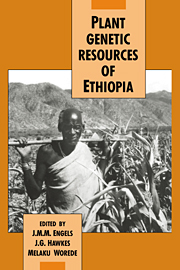Book contents
- Frontmatter
- Contents
- Contributors
- List of acronyms
- Preface
- Part I General introduction
- Part II The Ethiopian centre of diversity
- 2 The Ethiopian gene centre and its genetic diversity
- 3 Crops with wild relatives found in Ethiopia
- 4 Diversity of the Ethiopian flora
- 5 Forest genetic resources of Ethiopia
- 6 Plants as a primary source of drugs in the traditional health practices of Ethiopia
- 7 Traditional aromatic and perfume plants in central Ethiopia (a botanical and ethno-historical survey)
- 8 Spice germplasm in Ethiopia
- 9 A diversity study in Ethiopian barley
- 10 Sorghum history in relation to Ethiopia
- 11 Prehistoric Ethiopia and India: contacts through sorghum and millet genetic resources
- 12 Konso agriculture and its plant genetic resources
- Part III Germplasm collection and conservation in Ethiopia
- Part IV Evaluation and utilization of Ethiopian genetic resources
- Index
7 - Traditional aromatic and perfume plants in central Ethiopia (a botanical and ethno-historical survey)
Published online by Cambridge University Press: 30 October 2009
- Frontmatter
- Contents
- Contributors
- List of acronyms
- Preface
- Part I General introduction
- Part II The Ethiopian centre of diversity
- 2 The Ethiopian gene centre and its genetic diversity
- 3 Crops with wild relatives found in Ethiopia
- 4 Diversity of the Ethiopian flora
- 5 Forest genetic resources of Ethiopia
- 6 Plants as a primary source of drugs in the traditional health practices of Ethiopia
- 7 Traditional aromatic and perfume plants in central Ethiopia (a botanical and ethno-historical survey)
- 8 Spice germplasm in Ethiopia
- 9 A diversity study in Ethiopian barley
- 10 Sorghum history in relation to Ethiopia
- 11 Prehistoric Ethiopia and India: contacts through sorghum and millet genetic resources
- 12 Konso agriculture and its plant genetic resources
- Part III Germplasm collection and conservation in Ethiopia
- Part IV Evaluation and utilization of Ethiopian genetic resources
- Index
Summary
Introduction
The amazing variety of incense, perfumes and other aromatic materials gained our interest and attention when we collected spices in the marketplaces of Addis Ababa and its surroundings.
Aside from incense and myrrh very little is generally found in research literature about the use of plants as perfumes and aromatics in Ethiopia. In this paper those plants and plant products will be treated, which were found in markets in central Shewa, the administrative region around Addis Ababa and in the capital itself. Some plant products have also been reported from the Bale administrative region.
The subject will be treated in three sections: the first will deal with incense and myrrh and will consider their importance in international trade since ancient times. The other two sections will cover aromatic plant materials of different uses and perfume plants, respectively.
Incense and myrrh
From time immemorial the fragrant smoke of burning resins and the aromatic odours of ointments and balms have been used by Man in religious rituals.
In the ancient Mediterranean civilizations incense (or frankincense, as it is also called) and myrrh were considered, at times to be more precious than gold (Gauckler, 1970). The importance of incense in those days is documented by the fact that the first great trade route in history is called the ‘incense road’, covering a distance of about 5000 km from the kingdoms of southern Arabia (‘Arabia Felix’) to the cultural centres to the east of the Mediterranean Sea.
- Type
- Chapter
- Information
- Plant Genetic Resources of Ethiopia , pp. 114 - 122Publisher: Cambridge University PressPrint publication year: 1991
- 2
- Cited by



